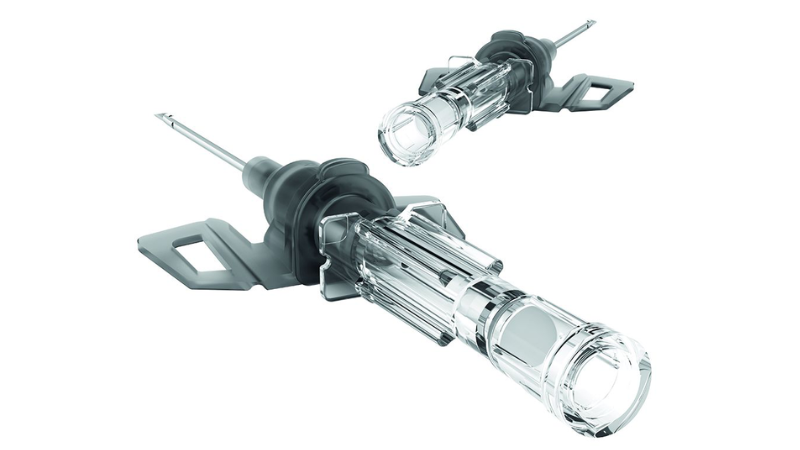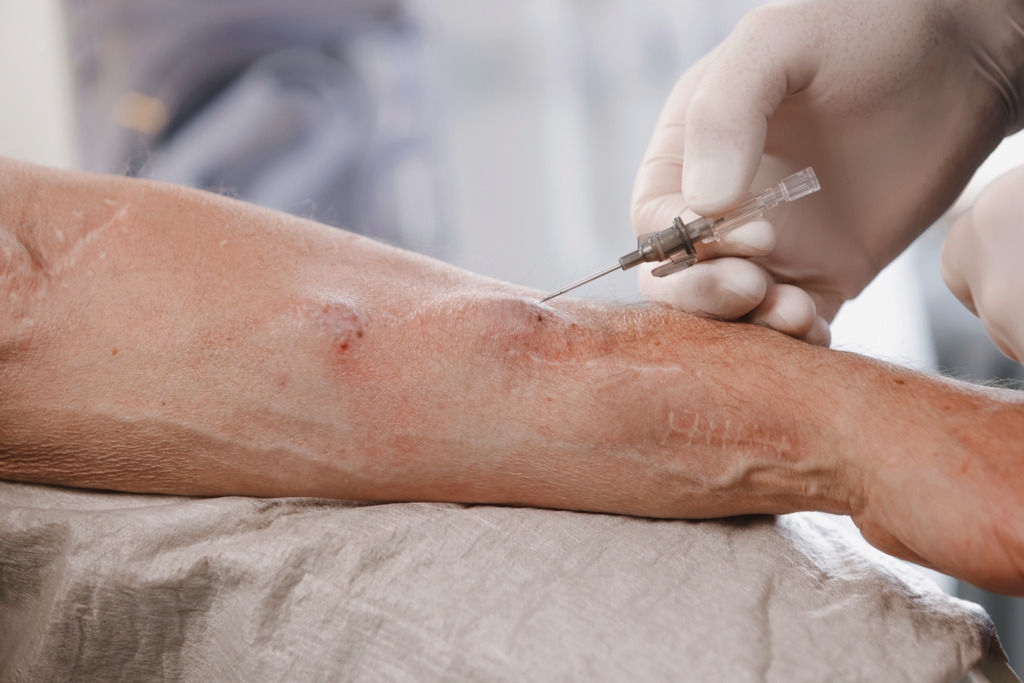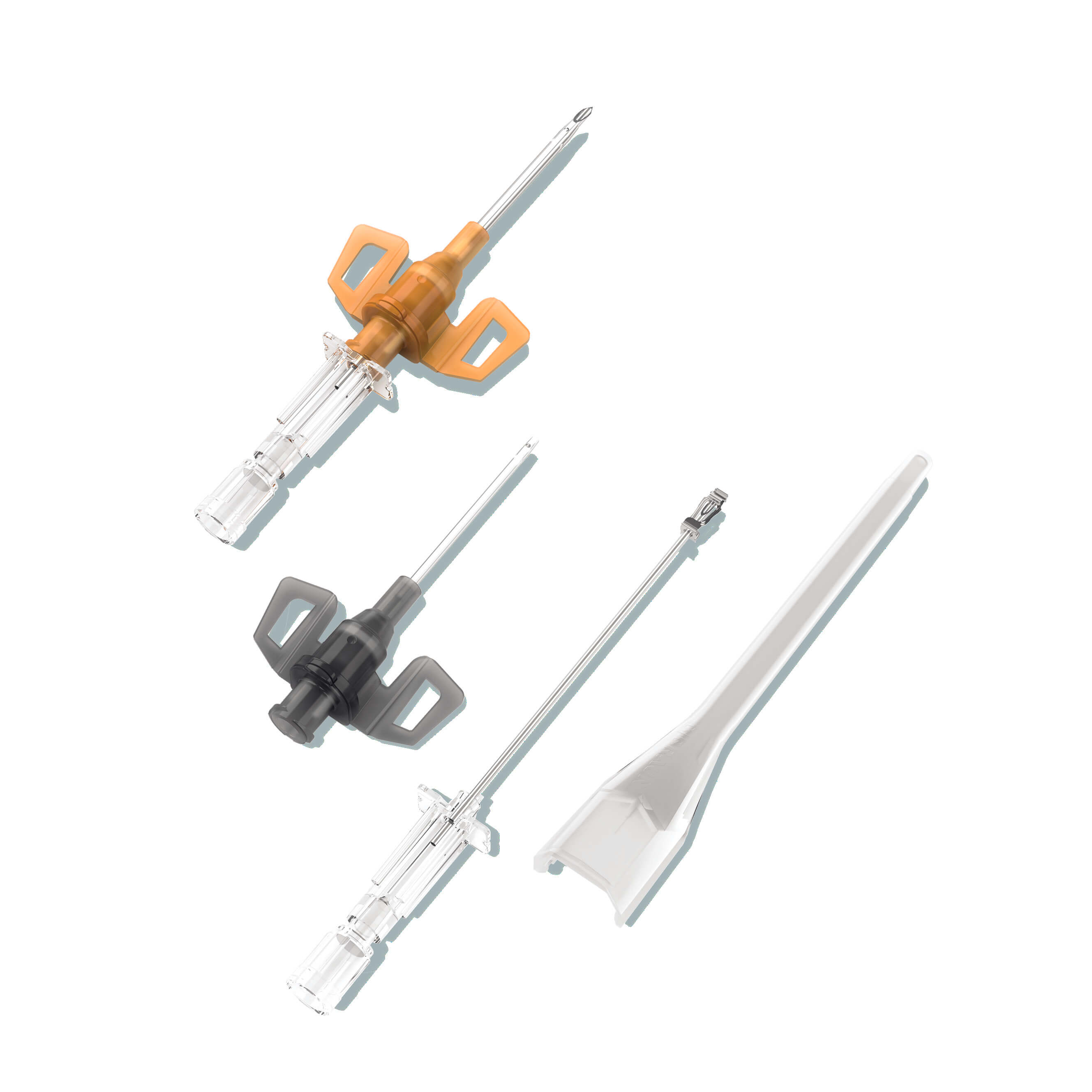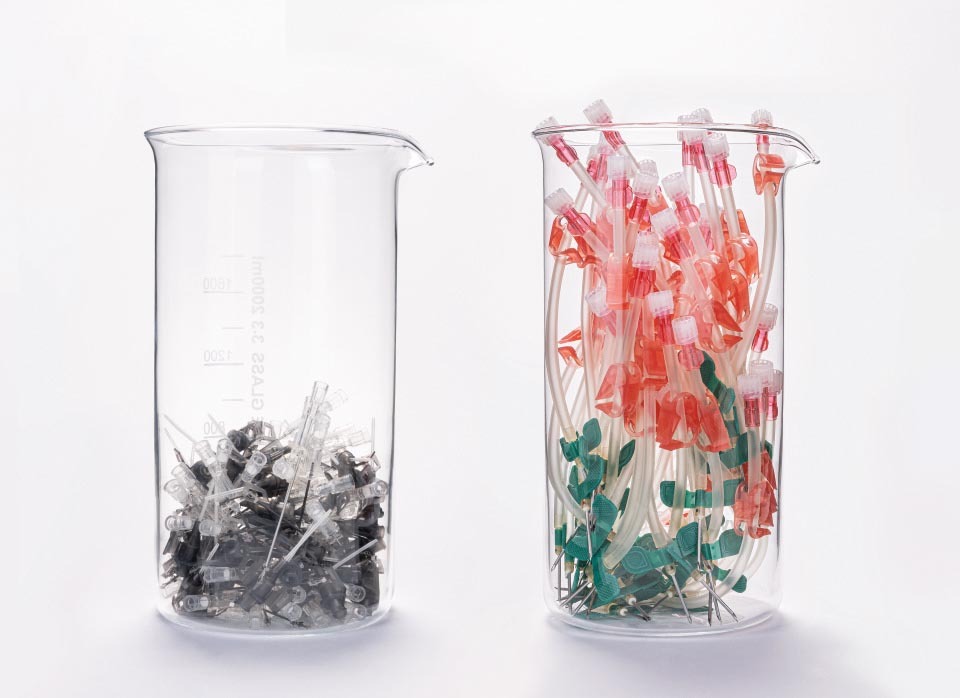No content results match your keyword.
Content
You have successfully logged out.
Not registered yet?
Peripheral Safety Catheter for Haemodialysis
The UK’s Next Generation Dialysis Catheter: Prioritising Patient Comfort, Clinician Safety, and Vascular Access Preservation.

Gaining vascular access via a fistula or graft is required over 300 times per year for each patient; this can be a painful and uncomfortable experience. Traditional steel needles present significant challenges that impact both patient wellbeing and clinical outcomes during dialysis treatment.
0%
Patients reported more comfort vs metal needles(1)
0%
Reduction in infiltration-related trauma compared to metal needles(2).
0%
Less contaminated waste per patient, supporting Net Zero NHS goals (3)
Diacan® Flex is engineered with a soft, flexible plastic catheter (FEP capillary) that remains in the vessel after the rigid introducer needle is removed. This critical change transforms the patient experience.

The back cut bevel design helps to reduce insertion pressure and helps to improve bleeding cessation time, resulting in less trauma to the vessel wall, which can potentially extend the lifespan of the vascular access(2, 8).
The catheter's flexibility allows it to bend and flex with patient movement, dramatically reducing the risk of infiltrations during treatment. As one patient noted: "It allows me to move my arm without making the machine alarm".
The catheter's flexibility allows it to bend and flex with patient movement, dramatically reducing the risk of infiltrations during treatment. As one patient noted: "It allows me to move my arm without making the machine alarm" (1).


In a study by Mid and South Essex NHS Trust, 100% of patients reported that Diacan® Flex was more comfortable—or significantly more comfortable—than traditional steel needles (1).
Clinical data demonstrates plastic catheters outperform metal needles in safety, effectiveness and cost. They reduce infiltration, vessel injury and insertion failure. These benefits translate into fewer interventions and long-term access improvements(2, 8, 9).

We are proud to partner with the National Kidney Federation to support the ITN ‘Understanding Kidney Health’ programme, which showcases how Tami, a Vascular Access Lead in Heartlands Hospital, uses plastic catheters to reduce discomfort for kidney patients during vascular access procedures and haemodialysis.
Diacan® Flex
The ergonomic catheter design of Diacan® Flex ensures both high-performance haemodialysis and vascular access efficiency.

Radio-opaque materials enhance visibility of both needle and FEP capillary - ideal for hard-to-palpate fistulas.
/
Back-cut bevel supports high first-attempt - helping to reduce pain and promote faster healing.
/
Wings provide secure fixation, helping to prevent catheter dislodgement during treatment.
/
Side holes create wave-like flow, reducing shear stress and occlusion alarms; whilst the design is engineered to support blood flow of 300 ml/min (16G)/ 500 ml/min (14G).
/
Diacan® Flex incorporates essential safety features that align with modern safety standards, including the EU Sharps Directive (2010/32/EU), to help protect staff from needlestick injuries (NSIs) and blood exposure(10).
An integrated, passive safety mechanism automatically covers the needle tip upon withdrawal. This eliminates the need for an additional activation step by the clinician, helping to minimise the risk of accidental NSI.
The catheter hub includes an inbuilt multiple blood control septum, which automatically closes upon disconnection of the bloodline. This feature significantly reduces the risk of undesired blood exposure and leakage.
The benefits are proven: less pain, fewer complications, improved staff safety, and a gentler approach to preserving a patient’s vascular access(1).
Download clinical data0g
Diacan® Flex weighs 6.66 grams less than conventional steel needles(3).
0kg
This difference can reduce contaminated waste by approximately 2.08 kg per patient annually(3).
0%
37% reduction in contaminated waste volume(3).
Diacan Flex uses two tiers of sustainable packaing. The outer shipping box is made from 100% recycled material and is itself fully recyclable. The inner dispensing pack contains 83% recycled content and is also 100% recyclable - together they cut landfill waste and support a circular economy.

1. Kumar, G. and Edwards, S. (no date) 'Exploring solutions to prevent venous needle dislodgements and vascular infiltrations during haemodialysis'. Mid and South Essex NHS Foundation Trust.
2. Marticorena RM, Dacouris N, Donnelly SM. Randomized pilot study to compare metal needles versus plastic cannulae in the development of complications in hemodialysis access. Journal of Vascular Access [Internet]. 2018 May;19(3):272–282. Available from: https://journals.sagepub.com/doi/pdf/10.1177/1129729817747535
3. Internal data on file.
4. Lok, C.E., Huber, T.S., Lee, T., Shenoy, S., Yevzlin, A.S., Abreo, K., Allon, M., Asif, A., Astor, B.C., Glickman, M.H., Graham, J., Moist, L.M., Rajan, D.K., Roberts, C., Vachharajani, T.J., Valentini, R.P. and National Kidney Foundation, 2020. KDOQI Clinical Practice Guideline for Vascular Access: 2019 Update. American Journal of Kidney Diseases, 75(4, Supplement 2), pp.S1-S164. Available at: https://www.ajkd.org/article/S0272-6386(19)31137-0/fulltext#:~:text=Abstract,GRADE%20Evidence%20to%20Decision%20frameworks. [Accessed 19 March 2025].
5. Kosmadakis, G., Amara, I. and Costel, G., 2021. Pain on arteriovenous fistula cannulation: A narrative review. Seminars in Dialysis, 34(4), pp.275-284. Available at: https://doi.org/10.1111/sdi.12979 [Accessed 19 March 2025].
6. Mathew AT, Strippoli GFM, Ruospo M, Fishbane S. Reducing hospital readmissions in patients with end-stage kidney disease. Kidney International [Internet]. 2015 Dec;88(6):1250–60. Available from: https://www.kidney-international.org/article/S0085-2538(15)61071-7/pdf
7. Duncanson, E.L., Chur-Hansen, A., Le Leu, R.K., Macauley, L., Burke, A.L.J., Donnelly, F.F., Collins, K.L., McDonald, S.P. and Jesudason, S., 2023. Dialysis needle-related distress: patient perspectives on identification, prevention, and management. Kidney International Reports, 8(12), pp.2625-2634. Available at: https://doi.org/10.1016/j.ekir.2023.09.011 [Accessed 19 March 2025].
8. Choi YS, Lee HS, Joo N, et al. Efficacy and safety of plastic cannulae compared with metal needles in the initial use of an arteriovenous fistulae in incident hemodialysis patients: a randomized controlled study. American Journal of Nephrology [Internet]. 2021;52(6):479–486. Available from: https://www.karger.com/Article/FullText/518095
9. Letachowicz K, Kusztal M, Gołębiowski T, Letachowicz W, Weyde W, Klinger M. Use of plastic needles for early arteriovenous fistula cannulation. Blood Purification [Internet]. 2015;40(2):155–159. Available from: https://karger.com/bpu/article/40/2/155/326736/Use-of-Plastic-Needles-for-Early-Arteriovenous
10. EU-OSHA, 2025. Directive 2010/32/EU - prevention from sharp injuries in the hospital and healthcare sector. Available at: https://osha.europa.eu/en/legislation/directive-2010-32-eu-prevention-sharp-injuries-hospital-and-healthcare-sector [Accessed 19 March 2025].
11. Prüss-Ustün A, Rapiti E, Hutin Y. Estimation of the global burden of disease attributable to contaminated sharps injuries among healthcare workers. Am J Ind Med. 2005 Dec;48(6):482-90. doi: 10.1002/ajim.20230. PMID: 16299710.
12. Huijben, J.A., Kramer, A., Kerschbaum, J., de Meester, J., Collart, F., Rodríguez Arévalo, O.L., Helve, J., Lassalle, M., Palsson, R., ten Dam, M., Casula, A., Methven, S., Ortiz, A., Ferraro, P.M., Segelmark, M., Mingo, P.U., Arici, M., Reisæter, A.V., Stendahl, M., Stel, V.S. and Jager, K.J., 2023. Increasing numbers and improved overall survival of patients on kidney replacement therapy over the last decade in Europe: an ERA Registry study. Nephrology Dialysis Transplantation, 38(4), pp.1027-1040. Available at: https://doi.org/10.1093/ndt/gfac165 [Accessed 19 March 2025].